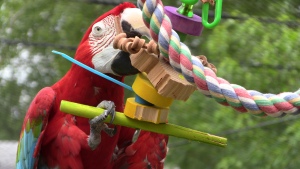
That’s easy. The animal will tell us. If my birds aren’t interacting with their toys, they are then call ‘obstacles’.
I spoke about this topic in detail at my last workshop, last weekend in Colorado. I mentioned that I don’t know what a ‘cockatoo toy’ looks like. I asked the audience “What does a macaw toy or a senegal toy look like?” I have no idea and I think this is a road block often thrown out to those that care for birds. There are a lot of people new to, or wanting to get more involved in the avian community and they hear these terms being used loosely. The problem I see regularly is these are people who are really looking to learn and want to provide mentally and physically stimulating enrichment for their birds or the birds under their care to interact. So they buy or make this ‘senegal toy’ and the bird doesn’t interact with it. The owner or caretaker hopefully will keep on searching for enrichment the bird will interact with, but the scary part could be the ones that think the bird not interacting with it is normal because this was the advice they were given. Then birds are sitting in cages or environments not interacting with the majority of it.
Birds and other animals learn from interacting with their environment. They learn from picking up a toy, manipulating a toy, and/or changing the shape of that toy. If they interact with that toy or manipulate that toy, it helps in bringing a sense of control into their environment. The toys also help include choice making decisions into their environment. If the toy is engaging and give some solvable challenges to it, then it also adds complexity to the toy. These are all areas I focus on when providing individual ‘appropriate’ enrichment to a bird’s environment.
Providing enrichment to my bird’s enclosures or environments is a major area of responsibility I owe to the bird. This was a decision I made when I took on the responsibility of caring for a bird in my house. If the birds aren’t interacting with their environment, I have work to do.
Leave a Reply